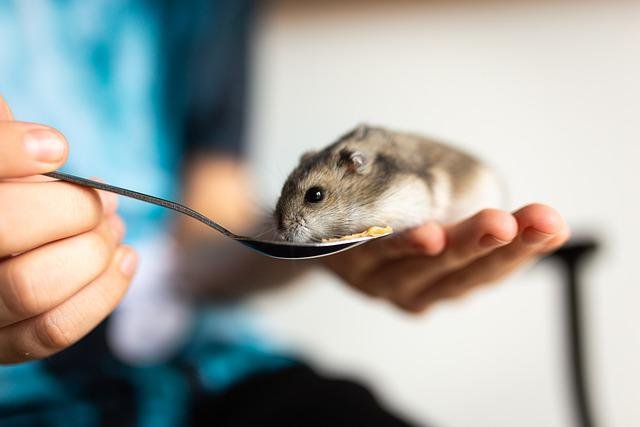Do hamsters have the capacity to cry?
If you’re responsible for the care of a pet, the happiness and well-being of that animal are of the utmost importance to you. For this reason, it is essential to become familiar with the ways in which animals such as hamsters communicate, particularly when they are experiencing discomfort or pain.
Understanding their sounds and motions may help avoid more severe illnesses and enhance their overall health and well-being.
Is this the sound that your hamster makes when it’s upset and yelling?
Even though they do not really cry, hamsters are known to let out cries and screams of despair when they are in a frightful or dangerous situation.
Hamsters do not weep, but the loud screaming and squeaking sounds that you may hear are designed to be as distressing as possible to catch your attention, much like emotional sobbing would be.
The only method for your hamster to communicate with you is by shrieking.
Hamsters, despite their charming, fluffy, and somewhat small look, are capable of and will employ piercing shrieks and weeping sounds when they are in distress or when they are experiencing discomfort.
When a person first gets a hamster, it might come as quite a shock to introduce the rodent to a new, comfortable cage while simultaneously seeing it scream and cry out in protest.
What are some of the reasons why a hamster can be crying out in pain?
The cries of a hamster, like those of most other species, are likely the result of pain, fear, or some other kind of misery. We tend to forget that as humans we are quite enormous and imposing, which means that a frightened hamster may have no other option except to cry out if we go too near to them.
It is important to keep in mind that hamsters in their natural environments are solitary animals; as a result, their social abilities are not the finest.
Other hamsters may scream when they are being handled or observed, but believe it or not, some hamsters will just scream because it is a taught habit or a stereotyped response that has nothing to do with their emotional condition.
You will undoubtedly notice over the course of time (or through Twitter memes or popular TikTok videos) that hamsters can be extremely loud, and they may express their unhappiness at the removal of food or treats by letting out a good old-fashioned scream!
What could be done about a hamster that is sobbing?
That the very first thing you should do is try not to panic. If you are going to be touching the hamster in any way, it is better to put it back in its cage and allow it some area to go about in.
To test whether the child would stop weeping and to buy some thought time to figure out what is wrong, loud settings and bright lights may be made quieter and dimmer. They will need to be brought to the veterinarian if there are any indications that they are in discomfort or if there are any concerns about their health.
The emotions of hamsters may be more complex than was previously believed…
If you’re confused about what your hamster, who you keep as a pet, is thinking, you should know that experts who research animal behavior are even more perplexed. This is due to the fact that the actions of the hamster cannot always be accepted at face value, which means that it is impossible to know for certain what is going on.
An unusual investigation conducted by a British scientific group and published in A reliable approach for determining a hamster’s emotional well-being has been developed by the Royal Society.
The researchers used a tool known as judgment bias, which may examine how a hamster’s disposition would influence its decision-making.
The experts collected a total of 30 hamsters and divided them up into their respective groups. The first group enjoyed their lives to the fullest in very luxurious cages that were stocked with an abundance of toys and pricey bedding. The second set of hamsters lived in a more rudimentary environment with just a wheel and some basic bedding.
These hamsters had been taught to differentiate between the sugar water and the quinine water contained in the drinkers located on the left and right sides of their housing respectively.
After that, these two varieties of drinkers were put into the corresponding hamster cohorts’ cages in the identical positions, and a third drinker was put in a position that varied.
The outcomes were very astonishing.
The group of hamsters that were allowed a more luxurious lifestyle had a 12% greater chance of approaching a drinker even when they were in close proximity to an unpleasant drinker.
This remarkable show of optimism in hamsters was reproduced when the hamsters were turned around, and the hamsters who lived in harsh conditions were given an improvement. It is hoped that by better understanding the favorable changes in behavior that hamsters exhibit, pet hamster care may be improved.
If you take the time to learn about your hamster, you will be better able to accommodate its demands… and listen to its screaming.
Screaming may be a phase that passes quickly as both you and your hamster are adapting to your new life together. Once you’ve ruled out any potentially life-threatening conditions, it’s possible that you’re dealing with a behavioral quirk that your pet utilizes to sometimes express discontent with you.
You will feel more certain that the care you are providing for your hamster is sustaining their wellness if you continue to investigate their behavior and watch it.
Are Bears More Likely To Visit Feeders With Hummingbirds?
What You Can Do To Prevent Animals From Digging Holes In Your Backyard
Florida Armadillos Removal Guide
Are Snakes On The Menu For Groundhogs?
Are Cardinals And Robins Friends With One Another?






